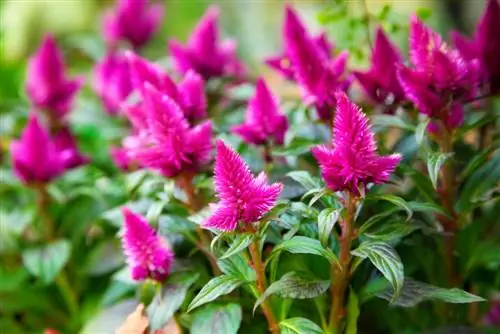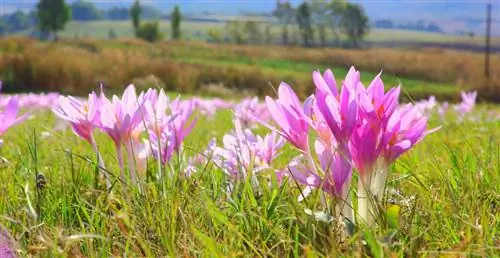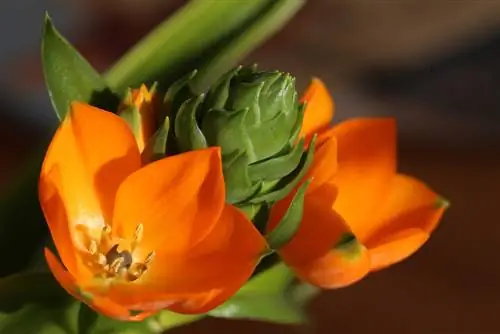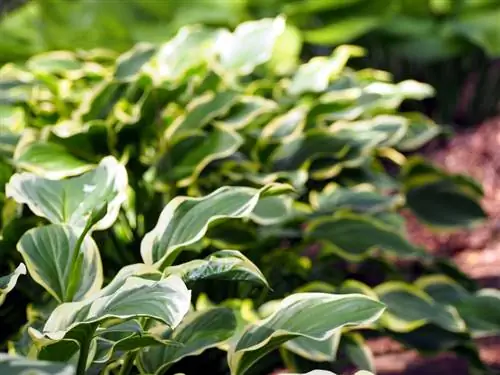- Author admin [email protected].
- Public 2023-12-25 17:45.
- Last modified 2025-01-23 11:21.
The plume attracts attention with its interesting growth habit. But the tropical plants are sensitive to the conditions outdoors. With appropriate care, you can enjoy the blooms for several years.
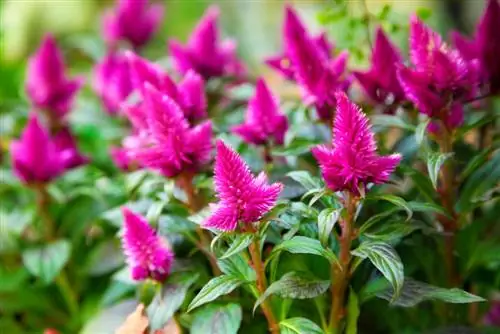
What are the characteristics and care instructions for a plume?
The feather bush (Celosia argentea) is a tropical plant with showy flowers in various colors. It prefers warm, bright locations and requires moderate water and well-drained, nutrient-rich soil. The plant is non-toxic and can be edible. Aphids and fungal infestations can cause problems.
Origin
The plume Celosia argentea belongs to the genus of firecrackers within the foxtail family. It has numerous common names such as silver brandy, daisy, cockscomb, velvet flower or Floramoor. Its original distribution area is in the tropical and subtropical regions of Central and South America, Asia and Africa. In China and India the plume is cultivated and used similarly to amaranth.
Growth
Like all species of smut, the plume has a characteristic appearance, which is indicated by the Latin genus name Celosia. Translated it means “flaming”. The perennial forms an unbranched and upright growing shoot. The plume grows comparatively quickly and reaches heights of between 30 and 80 centimeters. Most cultivated forms grow between 20 and 30 centimeters high. The plume is an annual or perennial plant that is often woody at the base.
leaves
Foliage leaves arise on the shoot and are divided into leaf blades and stems. The leaves appear lanceolate or oval to triangular. Their edge is smooth. They sit alternately on the stem. When the vegetation phase comes to an end, the dark green leaves change color and shine in attractive autumn tones.
Bloom
The terminal inflorescences are reminiscent of feathery bushes with a flame-like shape. They are made up of numerous individual flowers that form a spike. They are hermaphrodite and consist of three to five bracts. There are five stamens in the center of the flower, which are attached to the calyx at the base. The pistil is up to four millimeters long, which distinguishes the plume from other species of burnt crested plumes.
The species Celosia argentea develops reddish flowers with silvery nuances. There are now numerous breeding forms that have expanded the color palette. It ranges from white to yellow and organs to pink and flame red. The flowering period extends from June to September. An inflorescence lasts for up to eight weeks.
Usage
In Asia, feather bushes are cultivated as ornamental plants and food. They are used in herbal medicine. In Central Europe, the species, their colorful varieties and cultivars are used for planting in containers. They decorate roof gardens, courtyards and potted arrangements. In planters, the perennials beautify interiors and balconies, where they are cultivated as annuals. Celosia can be grown indoors all year round so that it blooms for several years.
The perennial thrives in the flower bed among other colored flowering plants. Here the perennial is cultivated as an annual. The plume harmonizes with marigolds and coneflowers. It serves as a gap filler and can be planted in small groups. With its eye-catching inflorescences, the plume appears very dominant. Therefore, it looks good as a soloist in a color-coordinated planter.
Edible
The plume can easily be used as an ornamental plant for the children's room or cultivated in households with pets. It is considered non-toxic in all parts of the plant. Its leaves can be prepared in a similar way to spinach. The young shoots produce a tasty vegetable that can be seasoned with garlic, hot pepper or chili. The colorful inflorescences can be used as edible decorations. The flowers garnish desserts and are a real eye-catcher in ice cubes.
Which location is suitable?
The cockscomb likes conditions similar to its tropical home. Young plants without flowers prefer a warm place that is bright and gets a lot of sun. The sun's rays stimulate the formation of flowers. As soon as they are in full bloom, a partially shaded location is necessary. The plants wither very quickly in the sun. Feather bushes thrive in a place protected from the wind. The Celosia prefers high humidity
The ideal outdoor space:
- bright and warm
- out of direct sun
- sheltered from the wind
- on a south-facing house wall
What soil does the plant need?
Normal potting soil is perfect for cultivating feather bushes. For better permeability, you should loosen the soil with sand or perlite. The cockscomb enjoys a nutrient-rich substrate that provides it with sufficient nutrients during flowering.
Propagation
The seeds are suitable for sowing directly in the bed. Since the plants with this method are very short-lived and die with the cold in autumn, you should plant the seeds between March and April. Temperatures of 18 to 20 degrees Celsius and a moist growing substrate on which the seeds are scattered are suitable. The light germinators are not covered with soil. They need high humidity to germinate. The seeds show tiny cotyledons after one to two weeks.
In the greenhouse
Ideal conditions for growing from seeds exist in a mini greenhouse for the windowsill. Ensure adequate ventilation every day. Once the young plants have reached a few centimeters in size, they can be placed individually in plant pots. After the Ice Saints they are planted in the bed.
Balcony
The plume feels particularly comfortable as a potted plant on the balcony if it has a warm and bright place directly on the wall of the house. Make sure that no waterlogging forms in the pot. Before you put the plant outside, you should wait for the last late frosts. Since they don't tolerate cold feet, the buckets should be placed on a wooden board.read more
Watering the plumes
The cockscomb has a moderate water requirement. It needs an evenly moist substrate so that its leaves don't droop. The root ball must not dry out. Make sure you have a regular water supply, which is more abundant in hot summer months. You can use the thumb test to check the moisture content in the substrate. Water the plant at the base to prevent water from running over the leaves. If water collects in the saucer, you should drain it. Mist the leaves daily to increase humidity.
Fertilize the feather bush properly
Freshly purchased plants do not need to be fertilized initially because the soil has been enriched with nutrients. If the plume is in the same pot for a longer period of time, it will enjoy a supply of nutrients every four weeks. Give the plant a liquid fertilizer through the irrigation water. Make sure you use the dosage sparingly, as the plant can quickly be over-fertilized. This makes them more susceptible to diseases and the flowers are less lush.
Cut the feather bush correctly
The plume does not require any pruning. If you regularly remove wilted inflorescences, you can stimulate rebloom and thus extend the flowering period.
How to prevent infections:
- use a sharp knife
- Clean the blade thoroughly before use
- Remove plant juices from the knife after cutting
How do I transplant correctly?
When moving the plant, you must be careful to damage as few roots as possible. The plume reacts sensitively to changes in the substrate. Potted plants that are cultivated for several years should only be repotted every two to three years. Perennials growing in the bed die off after one growing season due to the cold, making transplanting unnecessary.
hardy
The plume is not hardy. Outdoor perennials die back in autumn, while potted plants can be overwintered. As soon as the temperatures drop below ten degrees Celsius, the pot should be moved to winter quarters. This can be a greenhouse or the living room. The plants are overwintered at room temperature. During the winter months, plants need less water. The root ball should not dry out. Fertilization is not necessary until spring.read more
Pests
The plume is often attacked by aphids. They prefer to settle on weakened plants and suck juice from the leaf veins. The leaves turn yellow and die if severely damaged. Various home remedies can be used to combat pests. A decoction of garlic, onion or nettle is regularly sprayed onto the leaves. You can treat the plant with an extract from old coffee grounds. Sprinkle a few teaspoons of coffee grounds on the substrate to prevent pest infestation
Fungal infestation
With incorrect care and suboptimal site conditions, infestation by various fungi often occurs.
Powdery mildew
This fungus develops a mealy coating with a white or grayish color that covers the leaves of cockscombs. When ripe, small dark spots can be seen in the coating. This fair-weather mushroom spreads its spores in dry and warm conditions.
Gray horse
The mold spores prefer to settle on rotten plant parts. Rotten roots or shoot bases offer optimal growth conditions for the spores. Rotting is encouraged if the substrate is excessively moist. When watering, make sure that the water drains away and that no waterlogging occurs.
If the plant shows growth problems or discolored leaves, it should be removed from the substrate and checked for signs of rot. For most varieties, control measures are not worthwhile because they are cultivated as annuals. Perennial plants should be placed in fresh substrate after removing the rotten roots.
Tip
You can create colorful arrangements with the feather bush. Plant different colored varieties in a sufficiently large flower box. The opened flowers can be dried and used to embellish floral arrangements or dried bouquets.
Varieties
- Caracas: Variety of Celosia argentea. Blooms between July and August, magenta colored. Growth height between 15 and 20 centimeters.
- Venezuela: Variety of Celosia argentea. Blooms between June and September, purple. Grows between 40 and 50 centimeters high.
- Comfort: Suitable for low summer temperatures. Leaves bicolor with a dark center. Inflorescences small, purple.
- Celosia argentea var. argentea: ears white to light pink, tip turns pink with age.
- Celosia argentea var. cristata: Comb-shaped flowers reminiscent of coral. Different colored flowers. Up to 25 centimeters high.
- Celosia argentea var. plumosa: Flowers spiked in yellow, orange or red. Up to 45 centimeters high.

